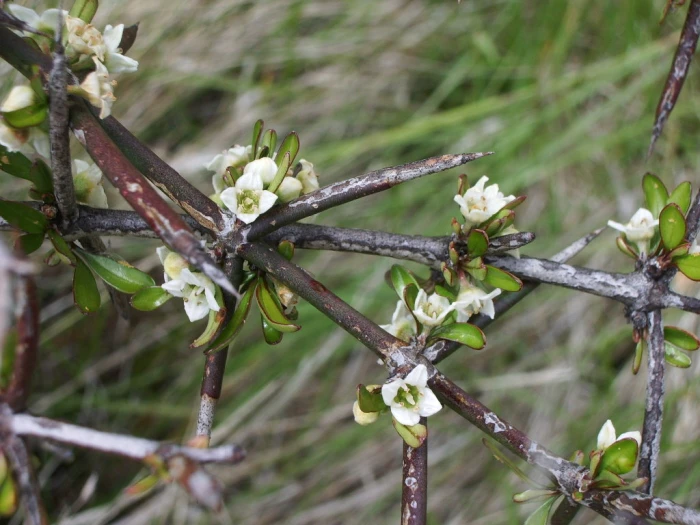Matagouri
(Discaria toumatou)
Matagouri (Discaria toumatou)
/
/

Sarang
Public domain
Image By:
Sarang
Recorded By:
Copyright:
Public domain
Copyright Notice:
Photo by: Sarang | License Type: Public domain | License URL: https://creativecommons.org/public-domain/ | Uploader: Sarang | Publisher: Wikimedia Commons | Title: Matagouri.jpg | Notes: User created page with UploadWizard |
















































Estimated Native Range
Climate Requirements for Walnut Creek, California
| This Plant | Your Site | Plant Suitability for Your Location | ||
|---|---|---|---|---|
| • Precipitation | 19" - 174" | 19" | Your precipitation may be insufficient for this plant. Irrigate N" / year. | Irrigate N" / year |
| • High Temp. | 56°F - 75°F | 86°F | Your summers may be too hot for this plant. | Too hot |
| • Low Temp. | 14°F - 44°F | 39°F | Your winter temperatures are normal for this plant | Excellent |
This plant should grow well at your location with about N inches per year (Y minutes per month) of irrigation.
Summary
Discaria toumatou, commonly known as Matagouri or Wild Irishman, is a deciduous shrub endemic to New Zealand, where it thrives in a variety of habitats including tussock grasslands, river terraces, and semi-arid scrublands. It typically grows to a height of 6-12 feet (1.8-3.6 meters) and a width of 3-6 feet (0.9-1.8 meters). Matagouri is characterized by its tangled, thorny branches and small, leathery leaves that are often found close to the thorns. The leaves are most abundant in spring or when the plant is growing in shaded conditions. The flowers, which bloom in spring, are inconspicuous, tiny, and white, lacking petals, and are followed by small red berries.
Matagouri is valued for its toughness and adaptability, making it suitable for windbreaks and erosion control in challenging environments. Its thorny nature can also provide a protective habitat for wildlife. In cultivation, it requires full sun exposure and can tolerate a range of soil types, provided they have good drainage. It is drought-tolerant, requiring low to medium amounts of water once established. While it is not commonly used in ornamental horticulture due to its thorny branches, it can be an interesting addition to native plant gardens or restoration projects.CC BY-SA 4.0
Matagouri is valued for its toughness and adaptability, making it suitable for windbreaks and erosion control in challenging environments. Its thorny nature can also provide a protective habitat for wildlife. In cultivation, it requires full sun exposure and can tolerate a range of soil types, provided they have good drainage. It is drought-tolerant, requiring low to medium amounts of water once established. While it is not commonly used in ornamental horticulture due to its thorny branches, it can be an interesting addition to native plant gardens or restoration projects.CC BY-SA 4.0
Plant Description
- Plant Type: Shrub
- Height: 6-12 feet
- Width: 3-6 feet
- Growth Rate: Moderate
- Flower Color: N/A
- Flowering Season: Winter, Spring
- Leaf Retention: Deciduous
Growth Requirements
- Sun: Full Sun
- Water: Low, Medium
- Drainage: Medium
Common Uses
Bird Garden, Butterfly Garden, Deer Resistant, Low Maintenance
Natural Habitat
endemic to New Zealand, where it thrives in a variety of habitats including tussock grasslands, river terraces, and semi-arid scrublands
Other Names
Common Names:
Scientific Names: Discaria toumatou, Discaria australis var. apetala, Notophaena toumatou
GBIF Accepted Name: Discaria toumatou Raoul